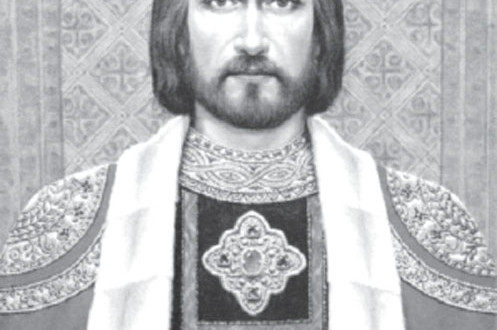by Al (Alvydas) Karaša

July 6, 2009 marks the 756th anniversary of the coronation of Mindaugas as the first king of Lithuania. This date, known as Statehood Day, is an official national holiday in Lithuania. But who was Mindaugas, where did he come from, and in particular, what do we know about his ancestry?
THE MEDIEVAL PERIOD OF Lithuania’s history is well documented. Much is MINDAUGAS The Roots of Lithuania’s First King by Al (Alvydas) Karaša July 6, 2009 marks the 756th anniversary of the coronation of Mindaugas as the first king of Lithuania. This date, known as Statehood Day, is an official national holiday in Lithuania. But who was Mindaugas, where did he come from, and in particular, what do we know about his ancestry? known of her early statehood after King Mindaugas; considerably less, however, about the period preceding his success in creating what many years later became the largest country in Europe; and very little is known about the leaders who ruled there before him.
Rulers of the people who lived along the east coast of the Baltic Sea in the first millennium A.D. were independent clan leaders with no permanent cooperation among the tribes they led. It would be another 250 years before the first steps in that direction. Western European cultural and political pursuits were already well defined, but Lithuania was still shrouded in paganism and did not appear significantly on the political world scene until the 13th century Baltic crusades by Teutonic knighthood drew attention from abroad. When it happened, it was sudden and unexpected.
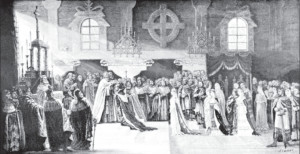
The man of consequence in that respect is said to have been the son of the renowned leader Ringaudas. But Ringaudas, in the opinion of most scholars, is nothing more than legend. There is no proof of his, or anyone else’s, paternity to Mindaugas – the man of interest here. It is reasonable to assume that Mindaugas, probably like his father before him; whoever he was; was an established pagan chieftain in his own right. Not much is known about the ascendancy of Mindaugas, even less about the man himself. He was certainly no tribal escapee from the primeval forest who showed up overnight. He was already a respected, astute diplomat and steeled warrior, much admired for his political acumen long before he made his mark in the world. The Rus-Swedish Vikings who founded Russia – called him Mindaugas the Wise.
He united the Lithuanian speaking Baltic tribes and forged them into a single federated nation. Once he earned world recognition as its leader, he found favor with the Pope in Milan and, in 1251 with his wife Morta, his sons and his entire court, was baptized, accepted Christianity for his subjects, and was crowned the first bona fide King of Lithuania two years later.
Who was this man?
Where did he come from? And who were his ancestors?
We have only the idealized images created by our artists, sculptors, writers, and poets. We see him in legend and in history books as a successful ruler who introduced Christianity to the last pagans in Europe without the need to employ the sword of the crusaders. Although Lithuania reverted back to paganism after his death in 1263, the gate was opened and the road to Christianity paved for his successors to follow.
It behooves us now to look at the post-Mindaugas rulers of Lithuania because more scholarship is available about this period. Its ties to the reign of King Mindaugas are incontrovertible. Studies of this period include the Grand Duke Gediminas, whose reign is well documented, although we don’t know any more about his father than we do about King Mindaugas’. Finding ancestral links to Gediminas helps narrow down King Mindaugas’ roots if only because we know more about the later ruling families of Lithuania in general.
Gediminas, who ruled Lithuania from 1316 to 1341, ruthlessly defended his country against the Teutonic Order. The Order spread lies about his heritage, labeling him a stable groom who murdered his lord and took his place. The Rus, whose lands he invaded, used these falsehoods against him which, in turn, benefited the Teutonic crusading cause. But his more astute contemporaries knew him to be high born with legitimate claims to nobility.
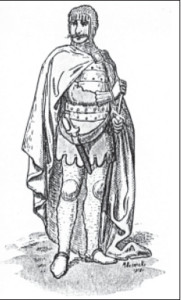
Which line of nobility was this? Because he and his son Algirdas had lasting ties to the Byzantine Empire, and historians noted their correspondence with Byzantine rulers in Greek, it was suggested that their ancestors may have been Greek. Given the similarity of some Lithuanian names and numerous words in Greek, this was an accepted theory for many years.
Other theories even claimed connection to the Holy Roman Empire. They were based on Christianity finally finding a home in Lithuania in 1387 when, under Vytautas the Great, Lithuania attracted world attention at the highest level. It was noted that the language had similarities to Latin and much of the educated population spoke Latin, knew Roman history, and studied contemporary Roman writings.
One fanciful story concerning Caesar’s wars with Pompey speaks of the defeated Roman commander Palemonas fleeing to the Baltic coast where he established himself as ruler over the Baltic tribes. By virtue of amber trade with these tribes, Roman knowledge of the Baltic was already strong. Palemonas is another personality shrouded in legend, but there are several notables in the history of Rome known by the same name. Who was to say one of them could not have later ruled in Lithuania?, or so the theory goes.
Once they embraced Christianity, Lithuanians were proud to be associated with the Holy Roman Empire and used it as moral argument against denigration for being the last pagans in Europe to be baptized. This also played well in Poland where Jogaila, the Lithuanian King of the PolishLithuanian Commonwealth established in 1385, could claim Roman heritage had the Byzantine theory proved invalid. Although upheld longer than others, the Roman theory was finally disproved in the 18th century by the German historian Schloesser. Later confirmation of his studies left no doubt the Roman theory was no more than legend, as were all theories before it.
And so, the roots of Lithuania’s first rulers defied discovery.
We must keep in mind that every legend grows out of some related truth, and legends which gave birth to these theories have an intriguing thread in common. Each one claims that Lithuania’s early rulers did not originate in the lands they ruled. Each one claims they came from somewhere else.
But where?
Descendents of Gediminas (Gediminaičiai) continue today. They are related by marriages to the highest royalty and aristocracy of Europe – Hohenzoller, Habsburg, d’Anjou, the Byzantine Emperors, English Kings, and so on. But their ancestral origins are a mystery.
More recent findings point to Lithuanian names with Germanic and Scandinavian connotations, such as Daugirdas – Dowgerd, Daumantas – Dowmont, Jogaila – Jogiello, Raugela – Rugiello, and so on. Presence of the “w” in the syllable dov is also suspect of Norman connections. Scandinavian Vikings, who were invited to rule along their extensive river trade routes with the East, were the original founders of Kiev’s Russia. Vikings (before they were known as Normans for their conquest of Normandy) had already conquered Southern Italy, Sicily, and Saxon England. Could they have delved deeper into Baltic lands, into Lithuania?
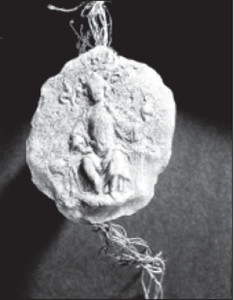
Copenhagen’s population is rich in Lithuanian sounding names even today. Alas, it is another theory laid to rest by archeological findings disproving any strong Norman presence in Lithuania. Names in Copenhagen are now known to be no more than misspelling coincidences erroneously interpreted by those unfamiliar with the Lithuanian language.
Studies of the origins of Lithuania’s first rulers continue. German, Polish and Lithuanian scholars are engaged in research to find ties between Mindaugas and Gediminas. Work carried out since 1935 indicates Duke Pukuveras as father of the future Grand Duke Gediminas. It also shows that the same person was often mistakenly identified as two or more different people because of name variations among different languages and the usual misspellings. It is suggested that Pukuveras may have been Butuvaras or Patuveras. This could lead to other unlikely associations breeding even more erroneous conclusions.
Josef Puzyna, the noted Polish historian, devoted his entire professional life to the research and study of the Gediminas dynasty. He discovered ancient sources and sought information in literature farther removed from conventional Lithuanian studies, which had not been tapped before, and looked at the subject from “outside the box”. Unfortunately, much of his work was lost to fire during World War Two, and Puzyna is no longer with us. His findings which survived, however, were published in 1947.
Further research could prove that the ancestry of Lithuania’s first king was Anglo-Saxon.
According to this study, Poczatki panstwowosci i dynastji litewskiej wedlug najnowszych badan (Lithuania’s statehood and dynastic beginnings according to the latest findings), the roots of Lithuania’s rulers extend to 11th century Britain!
There is a direct link to the well known defeat of the Saxons at the Battle of Hastings in 1066 when William the Conqueror established himself in the British Isles. The Saxon King Harold was slain at Hastings, but his sons and his daughter Gida escaped the Norman invasion. In 1074, this Gida married Vladimir Monomach, the Prince of Kiev, and her brothers ended up in Denmark; then Prussia and Lithuania. Their descendents assimilated and, 150 years later, included Dausprungas, who (according to Puzyna) may be the progenitor of the Gediminas dynasty.
And therein lies the link to Lithuania’s first king – Dausprungas was his brother!
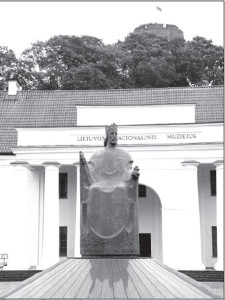
If the ancestry of Dausprungas is Anglo-Saxon, it also establishes the ancestry of Lithuania’s first king Mindaugas, as well as that of the Gediminas dynasty. Lithuania has ancient ties to Western Europe as well as Byzantium. Sixth century sources indicate that Anglo-Saxon incursions into the Baltic’s eastern shores predate those of the Vikings by 300 years. These ties also predate the aforementioned assimilation of the Saxon royalty who survived Hastings and supports their appearance in the Baltics. We should not be surprised that King Harold’s children fled to lands already familiar to the Saxons.
A recent Irish source has unearthed a medieval manuscript, evidently written by a missionary monk, which includes a very interesting fragment. The author claims to have attended the coronation of King Mindaugas. Had there been no ties to Britain, would this Irish monk have had the opportunity?
Should Puzyna’s findings prove genuine – and they certainly have merit – they may finally identify the roots of the Gediminas dynasty as well as those of Mindaugas, the first Lithuanian king, however unexpected and surprising it is that those roots could be Anglo-Saxon. Much work remains to prove this latest theory, but it is the most feasible one to date.
 DRAUGAS NEWS Lithuanian World Wide News in English
DRAUGAS NEWS Lithuanian World Wide News in English
